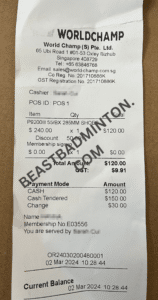
Before diving into the meat of this Victor P9200III review, let’s clear up any confusion regarding similar models.
One is the Victor P9200III 55th anniversary edition that I’ll be reviewing here. During my research, I was struggling to confirm if this model was the same as the original P9200III underneath the different paint job as many stores were sharing conflicting information.
Victor’s customer service team confirmed that it is indeed the same shoe model with the only difference being the paint job, the extra shoe bag, and a differently styled box.
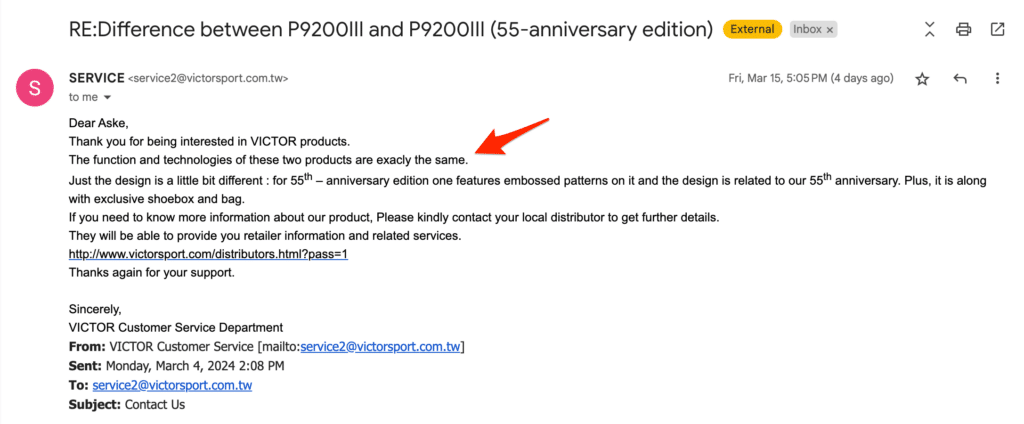
So far so good. But in Victor’s 2024 catalog, there are several P9200 models with nearly the same names. To make sure you don’t confuse any of those models with this one like I did, here’s a table listing them along with Victor’s footwear map (shoe matrix) comparing each one across their entire line-up (the arrows are my own).
| Brand | Model | Other |
|---|---|---|
| Victor | P9200TTY | |
| P9200III | This is the model I’m reviewing today (with the 55th anniversary paint job) | |
| P9200III TD | ||
| P9200 TD/F |
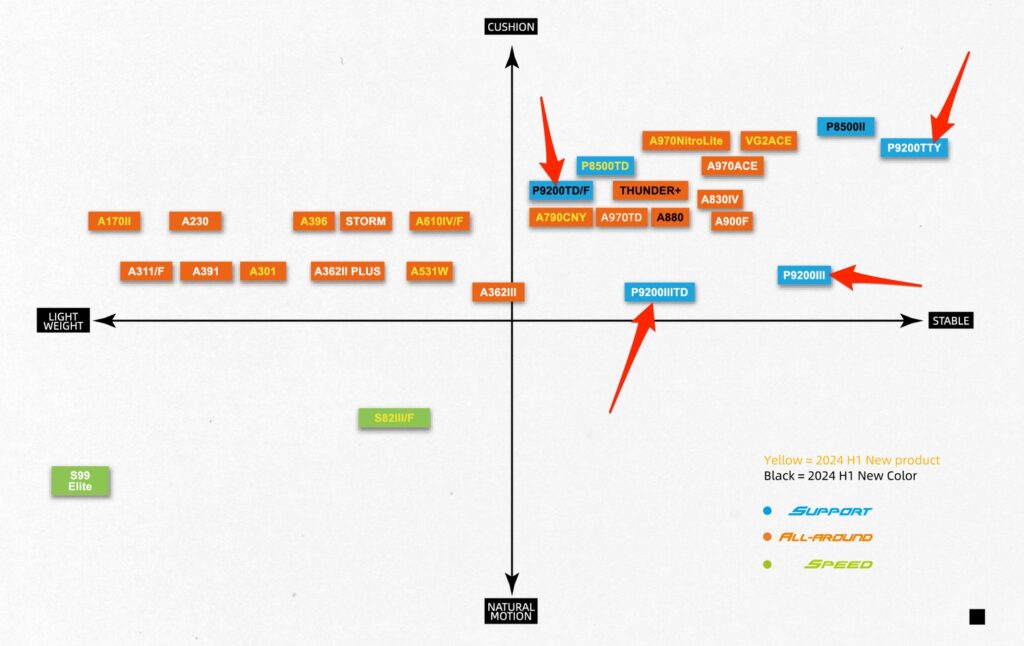
With such similar names, you’d think that these models would be similar to each other as well, but this isn’t the case as we can see in the matrix above.
The 55th-anniversary model I’m using here appears to be discontinued this year, but I’ve found it for sale at many shops in Western countries.
Victor naturally doesn’t compare their shoes with competing models directly, so I thought I’d take a stab at it.
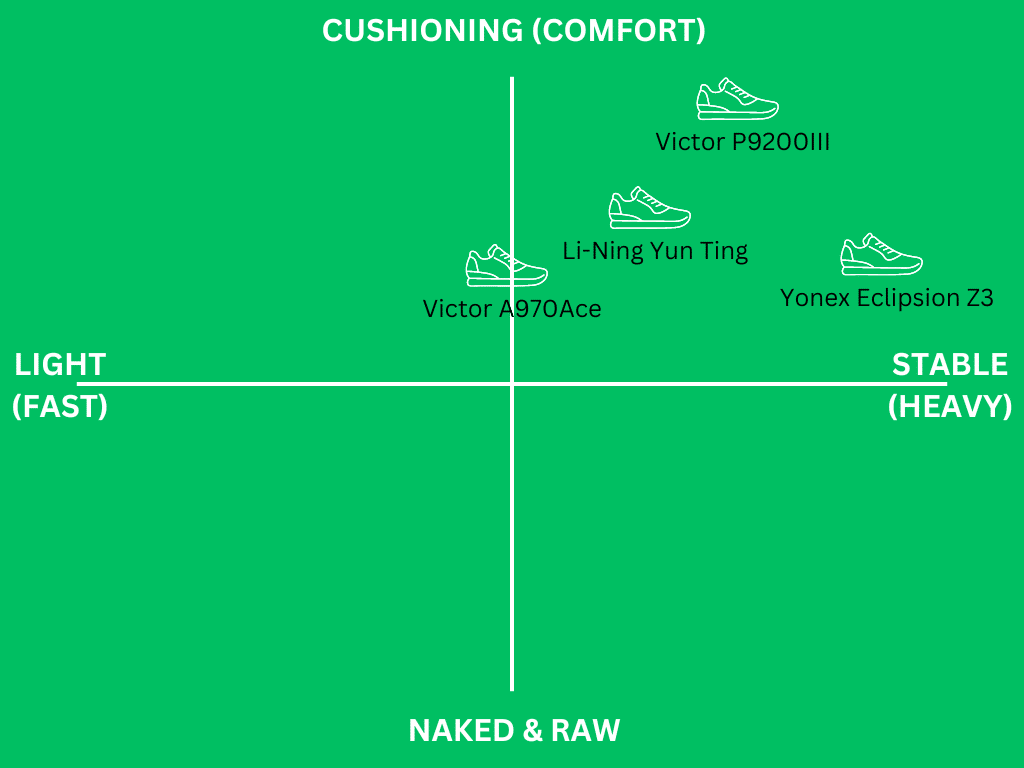
As you can see, this shoe is meant to be bulkier, more protective and comfortable than your typical all-around badminton shoe. In this shoe matrix, I’m comparing it to other similar shoes like the Li-Ning Yun Ting and Yonex Eclipsion Z3… but I couldn’t help myself and I just had to compare it to Victor’s A970Ace as that’s my current favorite shoe.
I haven’t been able to find any professional players using this Victor P9200III shoe on the World Tour, which makes sense as they tend to prefer lightweight and performance-based shoes.
Now that we’re on the same page about which model this review represents, let’s see how this shoe stacks up on the important metrics before comparing it head-to-head with other models.
Table of Contents
Victor P9200III review and my experience
This review is also available in video format.
Let’s start with the unboxing experience.
Unboxing and my first impression
This special edition of the P9200III offered a free shoe bag and a special box design as part of the overall 55th-anniversary package.
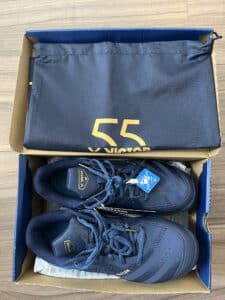
Besides the shoe itself, it also comes with a set of insoles, along with the drop-in midsole and instructions on how to place them within the shoe.
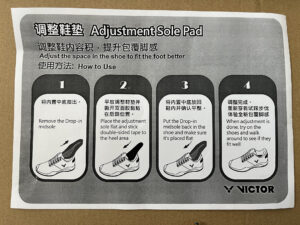
It was easy to figure out how to place the soles: as opposed to your typical badminton shoes, the thin insole goes underneath the drop-in midsole. The double-sided tape underneath seems to be there to hold the drop-in midsole in place. It won’t be touching your feet like you’re used to, only the drop-in midsole will.
Upon putting the shoes on for the first time, it seemed tight despite using the correct size. It’s most likely due to the nice cushioning as after breaking them in, they began to feel better. I’m pointing this out as you might feel the same if you try them on at the store and get concerned with the size.
As always, I’ve tested this Victor P9200III for ten hours on court in preparation for this review. First, let’s look at this shoe’s fit.
Fit (and upper area)
Overall, the fit feels good as you’d expect from a flagship shoe that focuses on support and protection. The toe box felt a little tight at first, but now that I’ve broken the shoes in and played with them, it feels just fine.
The sizing felt in line with other badminton shoes and brands, but if you’ve never used badminton shoes before you might find that you should go up by half a size.
The upper area near the tongue (above your foot) feels snug and similar to many other flagship badminton shoes.
Nothing unusual to report here, except that the tongue itself seems more cushioned than many other competing models I’ve seen. This is nice as some models can feel a bit sharp and stiff around your ankle.
The heel area
For badminton shoes that lean towards being more protective and cushioned as opposed to lightweight and fast, I’ve noticed just how big of a difference the heel can make.
I’ve found myself liking the higher upper part of the heel you’ll have on some of these models as your feet feel better locked into the shoe.
On this P9200III though, the heel feels low. It could be that the drop-in midsole elevates your foot more than I’m used to within the shoe, or the upper heel is just lower.
It has this thick sausage cushion at the upper heel all around the side near your ankles to help lock your feet in. But since it’s soft and cushioned, it doesn’t have that same effect of feeling locked in as stiffer models have.
It’s fairly comfortable, no complaints there, but not my preferred approach to the upper heel (it doesn’t look like much of a difference in these comparison images, but it feels like a lot).
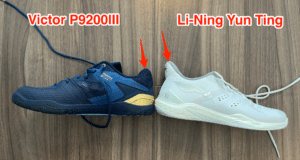

The outsole and grip
On other models, the outsole has been giving away clues as to ventilation, heat reduction, and stability, but since this model has a unique design due to Victor’s anniversary it’s hard to take away much from there without looking at the specs (which doesn’t tell us much about this area).
In terms of grip, I prefer Yonex’s radial sole grip, but it’s close. The outsole grip on this model is flagship shoe-worthy as you’d expect, and it isn’t worth selecting a different model just because of that.
The toe area and protection
When it comes to toe protection it feels like they threw one big cushion in there and overall, it’s good. Like with the rest of this shoe, it’s well cushioned and you’re unlikely to have any issues on hard stops or other things challenging your toe movement.
The upper part of the toe box felt slightly stiff compared to other competing models I’ve tried, but I doubt this will be an issue for you (like the Yonex Eclipsion Z3).
Cushion and shock absorption
This is where things get interesting as the new drop-in midsole comes into play. Just for this Victor P9200III review, I’m merging the insole section with this section as the drop-in midsole is both the midsole and insole all in one.
This is the most cushioned, couch-like and overall comfortable shoe I’ve tested thus far. I feel like I keep saying that with new shoes I test — I guess my horizon is expanding.
The P9200III feels spongy and nice when landing from a jump or lounge. I’ve especially noticed this during longer playing sessions when I’m tired. When I switch to all-around shoe models my feet feel sore underneath, whereas this model makes my feet feel less sore after playing.
In terms of grip between your feet and the insoles within the shoe, the rubbery sole feels highly resistant to sliding.
I found that getting the shoes on feels strange. The drop-in sole isn’t particularly smooth to slip into while wearing socks compared to your typical insoles. It’s slightly more inconvenient to put this shoe on, but once it’s on, your feet are not going anywhere.
Durability (and the Lunge Tear)
I’m giving this model a temporary score of 100% in durability as it looks the best during testing, especially when it comes to the Lunge Tear from the non-racket foot. Victor has applied their V-tough protection outside of that area and it’s been great so far.
(The Lunge Tear is what I call the inner side, for example, the left side of the left shoe, where your non-racket foot is used to slow your movement while lunging as that area tends to get a tear relatively fast).
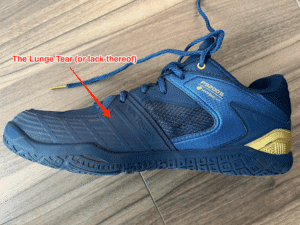
I’ll update this if anything changes as I play with them more (I’ll keep them in rotation for now).
Downsides
Someone online mentioned that this shoe felt bulky when they tried it in the store. They certainly do with all that cushioning, especially if you’re used to a light-performance shoe.
Support-based shoes tend to feel that way as there’s added extra padding for comfort and stability to help prevent injuries. It’s a matter of preference and if that isn’t for you, you might prefer an all-around shoe like the Victor A970Ace or Yonex’s SHB 65z3.
The conclusion of this Victor P9200III review
POSITIVE
The cushioning and spongy feeling when landing are great.
NEGATIVE
The fit doesn’t feel particularly locked in around your foot.
Victor P9200III: the verdict
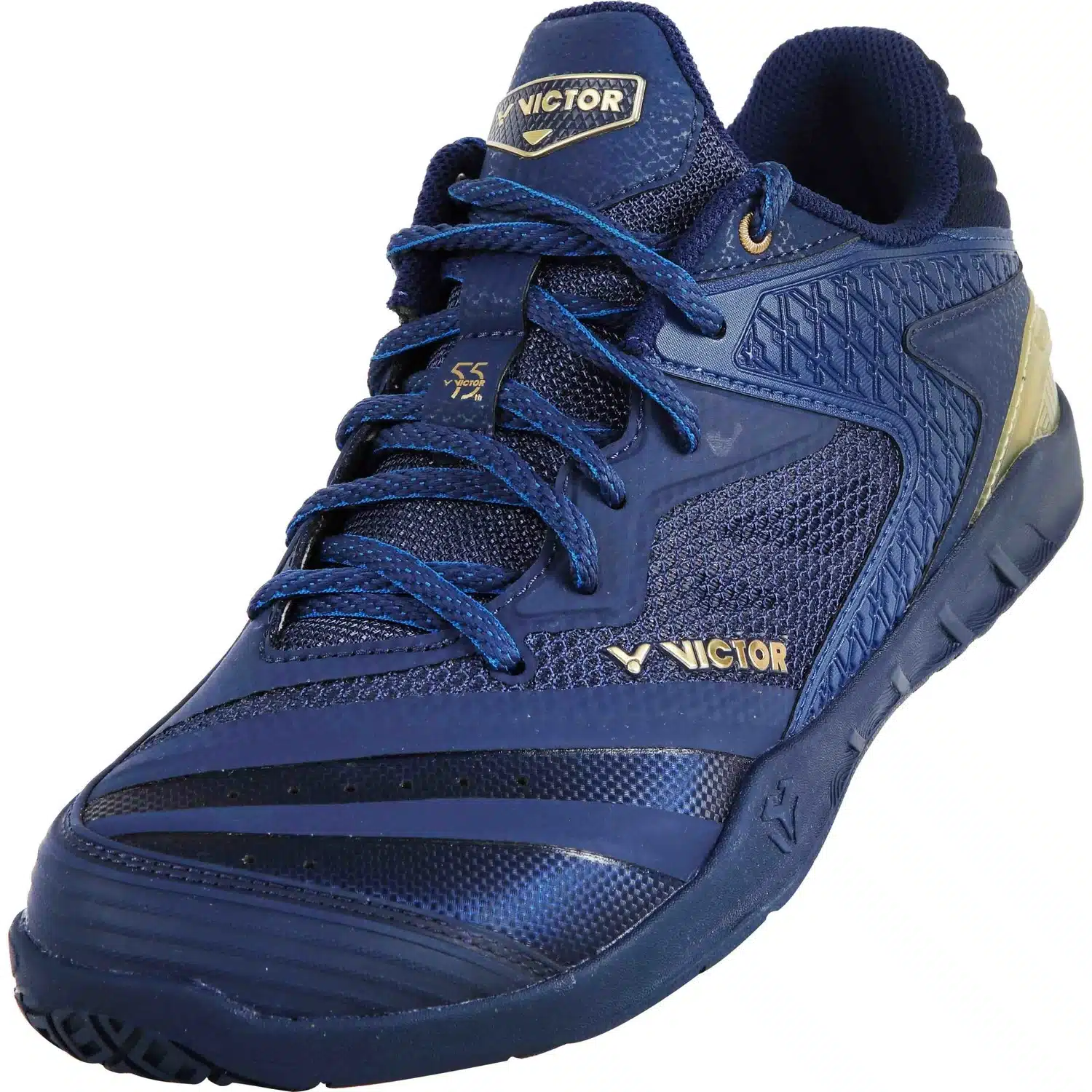
Summary
The P9200III feels unusually cushioned with barely any hint of stiffness compared to similar models.
It’s a badminton shoe with a focus on support and comfort rather than performance. That makes it bulkier than average and can feel slightly hot to play with during longer sessions.
Its cushioning and shock absorption are outstanding when landing from jumps or lunges.
Overall, you’re getting a decent deal in terms of value for money provided you’re looking for a shoe going all in on cushioning. If that’s you, the 55th-anniversary model seems to be on sale at many stores so you might get a good deal for a flagship shoe.
Technology and marketing used in this shoe
| Shoe Area | Specs | Tech | Description |
|---|---|---|---|
| Outsole | VSR Rubber | ||
| Midsole | HYPEREVA + Solid EVA | Neo Duplex (midsole) | Midsole tech for resilience and cushioning, and especially softness shock absorption along with lighter weight, apparently |
| Tri-Arch | Comfortable footbed design to distribute pressure more evenly | ||
| Drop-in midsole | Combined insole and midsole, increasing durability and comfort/support for landings and sideways moves | ||
| Upper | Microfiber PU Leather + V-Tough + Double Mesh | V-Tough for protection against lounge tears | |
| Inner Side | |||
(Source)
Marketing
“The P9200III inherits the legendary upper design of the P9200 while retaining the highly durable KPU material at the toe and tough Microfiber PU Leather, ensuring both comfort and durability. The shoe is further reinforced with TPU hot-melt bonding and TPU molding at the heel, enhancing the strength of the P9200III’s upper.”

“The P9200III incorporates VICTOR’s drop-in midsole technology, which provides support through tri-arch pressure-equalizing support, lifted outer rim, and the heel-stabilizing cup shape design. These features offer a comprehensive and supportive feel.”
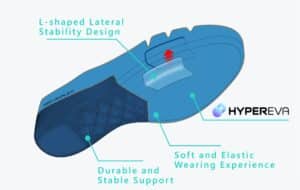
“The drop-in midsole material adopts VICTOR’s HYPEREVA high-performance lightweight and soft elastic midsole technology. It incorporates the NEO DUPLEX, providing lightweight and bouncy feel in the forefoot and stable support in the mid-to-rear section. This design enhances flexibility, resilience and offers excellent support and protection, catering the frequent abrupt stops and quick movements required in badminton.”
(Source)
Below is a nice comparison between a typical insole and the drop-in midsole.
Which badminton players are best suited for Victor P9200III?
Next up in this Victor P9200III review, let’s look at who this shoe is well-suited for.
Who P9200III is suited for
The P9200III is well-suited for recreational players who want to emphasize comfort and recovery due to the cushioning and shock absorption you’ll get with the model.
Who P9200III is not suited for
It isn’t well suited for players focused on performance as it is heavier and bulkier than many other models as it sacrifices light weight and speed for cushioning. Some performance players might even worry that it’s too soft and invites injuries.
Victor P9200III compared to other similar shoes
Finally, let’s compare this shoe with other similar models.
Victor P9200III vs Victor A970Ace
By now, I hope this Victor P9200III review has given you a fairly good idea about what this model is like. First, I’ll compare it to Victor’s A970Ace.
At the time of writing this, the Victor A970Ace has been my shoe of choice for a while. It’s an all-around model balancing light weight with being fairly comfy, but without scoring particularly high on the comfy-o-meter. Besides that, this model is super snug and well-fitting around my feet.
Compared to the P9200III, it’s lighter at 362 grams whereas the P9200III comes in at 370 grams.
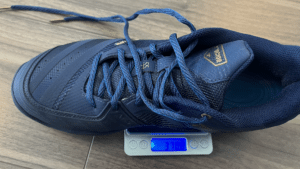
The 970Ace feels less like you’re wearing a shoe while playing as it feels less bulky and its higher heel with the purple pillows locks your foot in nicely.
The fact that the upper heel is lower on the P9200III makes it feel less snug around my feet, despite the soft and comfortable sausage cushion.
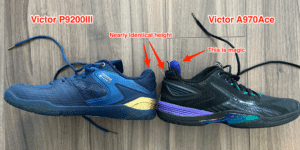
I know this sounds like I’m trying to sell you on the A970Ace model, but I couldn’t care less and stand to gain no benefit if you get it or not. All I’m saying is that it’s been a great shoe for my games.
In terms of fit, the P9200III is just fine, but doesn’t feel as snug and a part of my feet as the A970Ace, despite being more cushioned and soft to wear. The A970Ace feels glued to my feet as if something is tightly wrapped around them, whereas the P9200III feels like you’ve strapped a sofa underneath your feet.
At first, I didn’t notice that big of a difference in terms of heat between the two models, but the further I got into my sessions and the more tired I got, the more I noticed that the P9200III felt hotter and with less head reduction.
This makes sense as it comes with the drop in midsole which offers no ventilation, whereas the A970Ace comes with the standard insole and by virtue of being less bulky, makes it easier for the heat to escape. This wasn’t a big deal for me despite playing in a crazy hot environment (think 36 Celsius/96 Fahrenheit), but if this is a major priority for you it’s worth keeping in mind.
The P9200III feels more cushioned in the toe box, but in a different way than what I’m used to and it’s hard to describe. I believe it’s due to the drop-in midsole as the experience feels kinda spongy underneath your feet (in a good way).
On hard-stop lunges where you’re late and your toes get pushed forward in the shoe’s toe box, it’s certainly protective at the front and moreso than the A970Ace.
On the comfy-o-meter, the P9200III scores meaningfully higher as it’s more comfortable to wear. You might not notice it at first, but after a few hours of play when you’re tired and your feet feel used, you’ll notice just how comfy they are compared to the A970Ace. The latter feels more raw and that becomes more obvious the more tired you get.
The grip on the outsole feels about the same. The P9200III feels slightly better, which I imagine is due to them being brand new whereas my pair of A970Ace has normal wear and tear which shows on the outsole.
In terms of grip inside the shoe between your feet and the insoles, I didn’t notice any difference where one felt less sliding resistant despite one having the drop-in midsole and the other, the traditional insole.
It’s too early to tell if the durability will be the same, but I expect it as the material near the lunge tear appears similar.
Victor P9200III vs Li-Ning Yun Ting 01
Historically, the Li-Ning Yun Ting has been my favorite shoe as it blends a good balance of comfy cushioning and stiffness for stability, which helps avoid injuries like rolling around within the shoe.
I haven’t been playing with it as much as I’d like since I found that it gave me slight blisters on the side of the second toes. Odd, but annoying nonetheless.
In this section, I’ll compare it to the P9200III after having had both on court during the same session to compare them head-to-head.
Overall, the Li-Ning Yun Ting feels cushioned with a touch of stiffness, whereas the P9200III feels slightly more cushioned and less stiff. Both shoes are going in the same direction 85% of the way, but with slight differences.
The Yun Ting’s stiffness makes it more stable and more supportive in terms of protecting from injuries (i.e. the stiffer upper sides and heel lower the chances of rolling around within the shoe).
The upper heel is longer, stiffer, and, in my opinion, nicer than that of the P9200III as it helps create a feeling that your feet are more locked into the shoe. It’s not as stiff as in the Eclipsion Z3, though (more on that in a minute).
The same is true for the Yun Ting’s toe box. It feels slightly stiffer while the P9200III feels more cushioned, but that makes the upper area (if you point your toes upwards) nicer in the latter.
The grip from the outsoles felt similar in both shoes and I didn’t notice much of a difference. The insoles felt similar too in terms of sliding around within the shoes, despite the Yun Ting having your typical soft-ish insole while the P9200III has that new drop-in midsole.
I didn’t notice slipping at all, but the P9200III felt more spongy (which is nice when you land from a jump or lunge), soft, and oddly enough quite locked in against my socks. I’m guessing it’s due to the rubber feel, despite it not appearing as smooth as typical insoles when you touch them with your hands.
The Yun Ting’s fit underneath your feet feels different in a way that’s difficult to describe, almost like your foot’s arch becomes slightly different. It feels stiffer on the inner side of your foot underneath (i.e. the left side of the shoe on the left foot and vice versa), but not better or worse.
It feels like the shape of your foot within the shoe is slightly different when you change between them — this isn’t something you’ll notice if you aren’t testing shoes head-to-head, I imagine, and your feet will adjust quickly either way (it usually takes a game or two for my feet to adjust).
It’s hard to compare durability in a meaningful way this early. The Yun Ting has been just as good as other flagship shoes I’ve tested, but so far the P9200III is the only one with no visible lunge tear at all.
Victor P9200III vs Yonex Eclipsion Z3
The last thing I’d like to cover in this Victor P9200III review is a similar model from Yonex.
The Eclipsion Z3 is likely Yonex’ most direct competitor to the P9200III and follows similar traits although with one clear distinction: where the P9200III is a supportive shoe with loads of cushioning, the Eclipsion Z3 is a supportive shoe with a stiffer feel.
At first, you might think that the stiffness is a bad thing. It kinda feels that way when you first get them on. The stiff upper heel makes it a bitch to get these shoes on without using a shoe horn or hurting your fingers.
But the stiffer feel softens up after a few games. It’s not that they lose the stiffness over time (or at least that hasn’t happened to me yet), but rather it feels as if they mold after your feet while staying relatively stiff to keep feet where they should be.
This stiffness gives the feeling of better injury prevention as the fit feels more snug and locked in around your feet compared to the soft cushioning in the P9200III. The latter feels more forgiving which also means you get the feeling that there’s more room to move around within the shoe, even if there isn’t.
Where the P9200III feels like one big cushion, the Eclipsion Z3 has more select cushioning in certain places. One example is the toe box protection it offers at the front when your toes bump against the front of the shoe during hard stops.
On the other hand, the cushioning underneath the shoe feels softer and nicer in the P9200III. The drop-in midsole feels spongy and bouncy while moving around the court, and that helps you feel less tired in your feet after an intense session.
Moving on to the fit, I noticed that the lower part of the sides in the Eclipsion Z3 feels nice and contributes to the feeling of your feet being more locked into the shoe than in the P9200III. The Z3 gives the feeling that there is some kind of support that isn’t necessarily just cushioning.
To me, the upper heel in the Z3s is much nicer as it goes further up, and combined with the sides and the rest of the upper, offers a better overall fit around your feet. Ultimately, I like the stiffer fit in the Yonex Eclipsion Z3 more as it feels more snug.
3 comments
Aske, I have the new Li Ning Blade Max, but I feel that it gives me heel pain (potentially from not enough cushioning around the heel?)
How do you think the Victor p9200iii compares? Is it worth trying them, or better off to just get a heel insert for the Li Ning shoes?
Hey Merlin, ahh that sucks 🙁 the p9200iii feels like it has slightly less heel cushion than the Blade max in the heel area (or slightly stiffer — but the heel is super low on the p9200iii, so you have to be confident you like that style). I haven’t tried heel inserts yet – where is the issue with your heel? is it the fit causing it?
If you’re looking for comfort, you might like the new Thunder Pro – review coming very soon!
I just tried the Li Ning again during play, as well as just lunging at home. My issue with the heel is the shape and cushioning at the bottom. Upon lunging the initial contact point of the shoe is directly under my foot heel, and due to the (imo) low cushioning, it hurts my heel a bit.
I feel with other shoes, the initial contact point on the shoe is slightly behind foot’s heel, because the shoe’s bottom heel protrudes behind the shoe slightly more. This means that you can rock about the shoe’s bottom heel instead of direct impact below your own foot’s heel.
Will give the Victor p9200iii a go tomorrow, but it’s hard to find a Victor a970Ace in my city. I’ll also try the Yonex Power Cushion 65 (old variant, not Z or X etc.) as I’ve tried a lot of the other Yonex shoes which imo are also quite lightweight/not much cushioning.